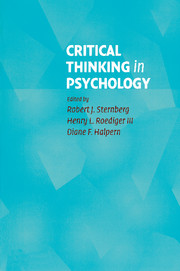Book contents
- Frontmatter
- Contents
- List of Illustrations and Tables
- List of Contributors
- Preface
- 1 The Nature and Nurture of Critical Thinking
- 2 Evaluating Experimental Research
- 3 Critical Thinking in Quasi-Experimentation
- 4 Evaluating Surveys and Questionnaires
- 5 Critical Thinking in Designing and Analyzing Research
- 6 The Case Study Perspective on Psychological Research
- 7 Informal Logical Fallacies
- 8 Designing Studies to Avoid Confounds
- 9 Evaluating Theories
- 10 Not All Experiments Are Created Equal
- 11 Making Claims in Papers and Talks
- 12 Critical Thinking in Clinical Inference
- 13 Evaluating Parapsychological Claims
- 14 Why Would Anyone Do or Believe Such a Thing?
- 15 The Belief Machine
- 16 Critical Thinking and Ethics in Psychology
- 17 Critical Thinking in Psychology
- Author Index
- Subject Index
- References
8 - Designing Studies to Avoid Confounds
Published online by Cambridge University Press: 05 June 2012
- Frontmatter
- Contents
- List of Illustrations and Tables
- List of Contributors
- Preface
- 1 The Nature and Nurture of Critical Thinking
- 2 Evaluating Experimental Research
- 3 Critical Thinking in Quasi-Experimentation
- 4 Evaluating Surveys and Questionnaires
- 5 Critical Thinking in Designing and Analyzing Research
- 6 The Case Study Perspective on Psychological Research
- 7 Informal Logical Fallacies
- 8 Designing Studies to Avoid Confounds
- 9 Evaluating Theories
- 10 Not All Experiments Are Created Equal
- 11 Making Claims in Papers and Talks
- 12 Critical Thinking in Clinical Inference
- 13 Evaluating Parapsychological Claims
- 14 Why Would Anyone Do or Believe Such a Thing?
- 15 The Belief Machine
- 16 Critical Thinking and Ethics in Psychology
- 17 Critical Thinking in Psychology
- Author Index
- Subject Index
- References
Summary
The ability to design studies that are free from confounded variables is an acquired skill that separates the true psychological scientist from a layperson. The latter might be quite capable of generating interesting questions that could be addressed by psychological research; turning these questions into a study that cleanly tests the hypotheses, however, can be quite a challenge. It is this topic that the present chapter addresses.
Consider the fundamental goal of psychological research: to discover the causes and consequences of behavior. The only way to make such discoveries is to be able to examine data from a study that is free from alternative explanations. Such alternative explanations most often arise when an experiment contains confounded variables. Confounded variables involve the “simultaneous variation of a second variable with an independent variable of interest so that any effect on the dependent variable cannot be attributed with certainty to the independent variable” (Elmes, Kantowitz, & Roediger, 2003, p. 436). A well-designed study is one in which the researcher has carefully considered potential alternative explanations and designed the study so that these alternative explanations are no longer viable.
Psychological research can be categorized into two broad classes: experimental studies and correlational studies. In the former case, the researcher manipulates the variable of interest (the independent variable) and observes its effects on the dependent variable. The latter involves examining variation that occurs naturally (e.g., the variation between emotional awareness and happiness) and attempts to draw conclusions regarding this relationship.
- Type
- Chapter
- Information
- Critical Thinking in Psychology , pp. 131 - 142Publisher: Cambridge University PressPrint publication year: 2006
References
- 1
- Cited by

